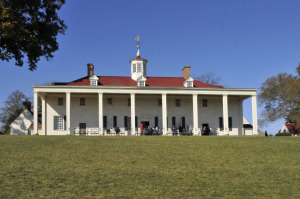Washington inherited a half-interest in Mount Vernon, near Alexandria, Virginia, from his half-brother Lawrence, who had named the property after a British admiral. In 1758, before obtaining complete ownership, Washington began enlarging the small farmhouse his father had built overlooking the Potomac River. Upon reaching its current size in 1774, the house encompassed 11,028 square feet and 21 rooms. The exterior was covered by bevel-edged blocks of yellow pine, made to resemble stone by pouring a layer of sand onto wet paint. At Washington’s instruction, the weather vane atop a hexagonal cupola featured a dove with an olive branch of peace in its mouth. Washington also designed the two-story piazza facing the river that was widely copied.
At its peak, Washington’s Mount Vernon plantation included 8,000 acres, devoted primarily to tobacco and wheat and worked by hundreds of slaves. By 1797 Washington had soured on slavery and upon his death in 1799 he bequeathed the 123 slaves he owned to his wife Martha, with instructions they be freed upon her death. She freed them a year later. Visitors since 1833 have reported a slave cemetery on the property, but surface evidence of it eventually disappeared. On September 21, 1983, the Mount Vernon Ladies Association, owners of the property since 1858, dedicated a cylindrical monument near the tombs of George and Martha Washington to mark the graves of “Afro Americans who served as slaves at Mount Vernon.”
Mount Vernon’s mansion, outbuildings and 500 remaining acres are open to the public 365 days a year, reflecting Washington’s hospitality while living there. Of the more than 80 million visitors since then, only those since 2007 have been able to purchase whiskey from a working replica of Washington’s distillery.
